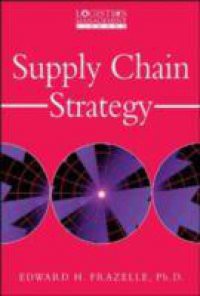High-Tech and High-Touch Logistics Solutions for Supply Chain Challenges In today's fast-paced and customer-oriented business environment, superior supply chain performance is a prerequisite to getting and staying competitive. Supply Chain Strategy is based on world-class logistics practices in place in successful supply chain organizations, the latest academic breakthroughs in logistics system design, and the logic of logistics. It presents the proven pillars of success in logistics and supply chain management. Part of McGraw-Hill's Logistics Management Library, Supply Chain Strategy is organized according to author Dr. Ed Frazelle's breakthrough logistics master planning methodology. The methodology leads to metrics, process designs, system designs, and organizational strategies for total supply chain management, total logistics management, customer response, inventory planning and management, supply, transportation, and warehousing. Concise yet complete, Dr. Frazelle's book shows how to develop a comprehensive logistics and supply chain strategy, one that will both complement and support a company's strategic objectives and long-term success. Logistics the flow of material, information, and money between consumers and suppliers has become a key boardroom topic. It is the subject of cover features in business publications from Wall Street Journal to BusinessWeek. Annual global logistics expenditures exceed $3.5 trillion, nearly 20 percent of the world's GDP, making logistics perhaps the last frontier for major corporations to significantly increase shareholder and customer value. And at the heart of every effort to improve organizational logistics performance? Supply chain efficiency. Supply Chain Strategy is today's most comprehensive resource for up-to-the-minute thinking and practices on developing supply chain strategies that support a company's overall objectives. Covering world-class practices and systems, taken from the files of Coca-Cola, Wal-Mart, General Electric, and other companies, it covers essential supply chain subjects including: Logistics data mining for identifying the root cause of material and information flow problems, pinpointing opportunities for process improvements, and providing an objective basis for project-team decision making Inventory planning and management presenting metrics, processes, and systems for forecasting, demand planning, and inventory control, yielding lower inventory levels and improved customer service Logistics information systems and Web-based logistics helping to substitute information for inventory and work content Transportation and distribution for connecting sourcing locations with customers at the lowest cost by, among other things, leveraging private and third-party transportation systems Logistics organization development including the seven disciplines that link enterprises across the supply chain, as well as logistics activities within those enterprises Supply Chain Strategy explains and demonstrates how decision makers can use today's technology to enhance key logistics systems at every point in the supply chain, from the time an idea or product is conceived through its delivery to the final user. It describes the major steps in developing an effective, workable logistics management program one that will reduce operating expenses, minimize capital investment, and improve overall customer service and satisfaction.

